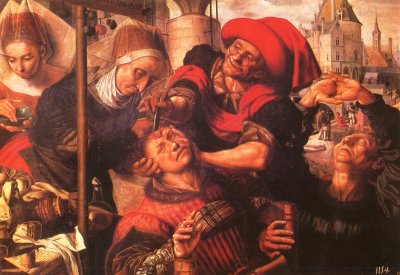|
Prado, Madrid 
Museo alemán de epilepsia en Kork www.epilepsiemuseum.de |
In the Renaissance, stones were regarded to cause epilepsy. People believed themselves to be more enlightened and more scientific, and the demons which came out of the mouth of the person with epilepsy and were supposed to be the cause of the disease, gradually disappeared in the visual arts. Now it was gemstones which were believed to act as a remedy or an amulet against epilepsy. The following example is taken from a book written by the doctor Antonius Mizaldi: "Aristotle and later Albertus write that an emerald worn round the neck prevents people from contracting the falling sickness and sometimes drives the sickness away. For this reason families of the nobility like to give their children this stone to wear round their necks so that they do not get this evil disease." |



